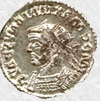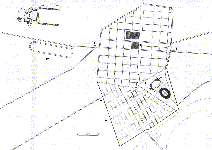
Ubicación respecto a la ciudad romana |
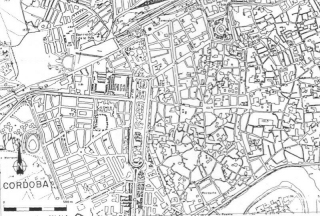
Ubicación respecto a la ciudad actual |
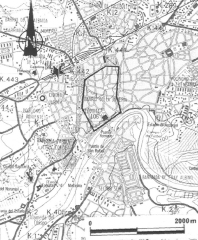
Ubicación sobre el mapa |
The complex of Cercadilla, although inscribed nowadays in the layout urbanistic of Cordoba, it is situated in an outlying area. It is inside of the lands occupied by the layout of the railroad from the c. XIX what has allowed it conservation. In relation with the walled enclosure of the Roman city it is situated sum up 600 meters of the Northwest angle and 650 meters of the nearest door.
It can not be considered inscribed in the rural surroundings but
being part of the own city transforming by this way the image of
the Cordoba late imperial.

Ubicación respecto a la ciudad romana |

Ubicación respecto a la ciudad actual |

Ubicación sobre el mapa |
When the excavation began it was thought that the construction of the building in the urban perimeter of the Roman city was motivated by its big dimensions. At the present moment and thanks to the results of the last works carried out in the site, was the presence of a pre-existent circus the reason of such decision. This circus, situated close to the united, conditioned the place of the new palace that was built deliberately in the neighbourhood of this circus.
We are talking about an unique building. It is organized in function of a wide semicircular exedra defined by a cryptoportico with 109 diameter meters. Over this it is located a corridor with portico through that you can enter to the different buildings and spaces of the complex.
Nevertheless, the adoption of the approach in exedra can not be considered an original innovation. It constitutes an element that has a lot tradition in the Roman architecture and that it is reproduced in the building of Cercadilla. The originality of the palace is in the conception of the exedra like agglutinative and centralizing element of the buildings that surround it.
Functionally the big exedra constitutes a big open square, free of constructions that it plays the part of welcome space for those that have the privilege to enter inside the palace. The portico in sigma allows the entrance to the different reception spaces that surround it. The scenography of the united is fomented by the own radial distribution of the buildings surround it.
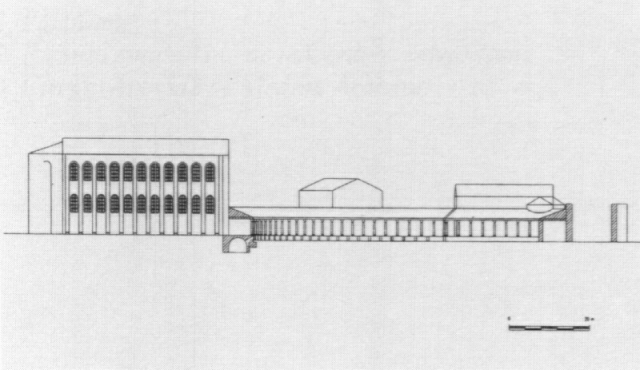
As much the originality and formal characteristic of the design as the technical of building used for their materialization constitute obvious sings of the presence of a strange architect. This, the work’s managing, would be very familiarized with the imperial tetrarchic architecture. Not only provided a singular architectural design but, for their execution, it imposed a concrete technical of building. This, was related directly with the one that was applying in the architecture of the moment, which was habituated and linked.
For the exact date of the monument we have different approaches like the stratigraphic sequence, the architectural analysis and the epigraphic evidence .
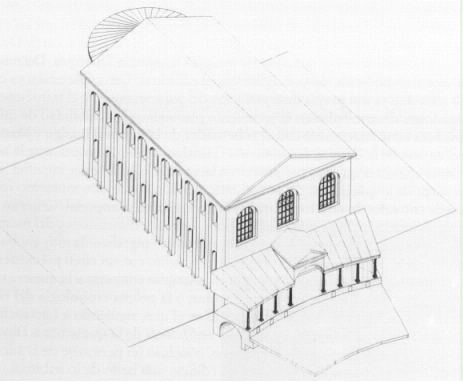 The
architectural analysis provides important chronological approaches especially
in the matter to the central room. As much for their location, in the
axis’s top, as for their own configuration, it is the room with the most
relevance of the whole united. The design applied for the building attainment
responds to the model of the room which have strictly longitudinal floor.
It have an only one rectangular nave crowned in apse with covered
to two waters and wooden plane roof usually preceded by a portico. This
floor, imbued of a strong sacred character, it is the room in which
the enthroned emperor stay, it has an important development in the lateage.
In the moments between the c. III at the IV and in the first moments of
the c. IV this model take a great impulse. Directly connected to the tetrarchic
architecture it was chosen preferably for the configuration of the big
rooms dedicated to the imperial audience.
The
architectural analysis provides important chronological approaches especially
in the matter to the central room. As much for their location, in the
axis’s top, as for their own configuration, it is the room with the most
relevance of the whole united. The design applied for the building attainment
responds to the model of the room which have strictly longitudinal floor.
It have an only one rectangular nave crowned in apse with covered
to two waters and wooden plane roof usually preceded by a portico. This
floor, imbued of a strong sacred character, it is the room in which
the enthroned emperor stay, it has an important development in the lateage.
In the moments between the c. III at the IV and in the first moments of
the c. IV this model take a great impulse. Directly connected to the tetrarchic
architecture it was chosen preferably for the configuration of the big
rooms dedicated to the imperial audience.
We can appointed to this model the palatine room of Trier , the Galerius´ rooms in Gamzigrad and Thessalonika -last one very doubtful-, the village of Diocletian in Split-up and the Maxentius' in the Apia road. The outside architectural configuration, in function of the buttresses around the built, has a special similarity with the Constantine’s room of Trier. This formal bond can understand as result of each other influences, or as a common precedent model unknowned nowadays.
After the comparation between the sizes of the different rooms and their hierarchization, we check that the building which has the bigger size of all is the Constantine´s room of one Trier. The Galerius´ and Cordoba’s rooms are very similar but smaller than the previous. Both of them are bigger than the Maxentius´, Diocletian´s and the Palace I of Galerius in Gamzigrad. After that we can enclosed the Cordoba’s room as one of the bigger imperial rooms in the tetrarchic ages. The rooms of the high administration or domestic have smaller size and it constitute the pattern of the imperial reception room in other buildings.
Nevertheless, the epigraphic remainders tell us the real date and interpretation of the palace. The own evolution of the monument, which had a systematic looting of the constructive material, has deprived us of the most epigraphic remainders which should had the united. So we only have two evidences.
The first one is some litterae aureae, which have interest for the own interpretation of the palace, but from a chronological point of view they do not contribute us very much. The second one it is a marble-like plate fragment recovered inside the one of the frigidarium´s bathrooms in the thermal baths. At this one the caesares Constantius I and Galerius are mentioned. The inscription should be dated between the 1st March of the year 293, when the caesares acquires their range, and 1st May of the year 305., when Diocletian and Maximian abdicated and they become in August. The second Tetrarchy had began. Among these years the building of Cercadilla was already built.
In this chronological environment we know that Hispania, Italy and Africa, depends directly on Maximian. Also, we know that Maximian was in Hispania in those moments. In short, among 296 - 297, he goes to North Africa to carry out a pacified campaign against the Mauri´s tribes. Likewise he spent sometime in Hispania warring against the frank piracy who was lashing the Atlantic coast.
In this context, we can affirmed that Maximian it is the only personage
who could built this monumental united in Cordoba. This should understand
inside the design of the new control system and defence of the territory
implanted by the Tetrarchy.
